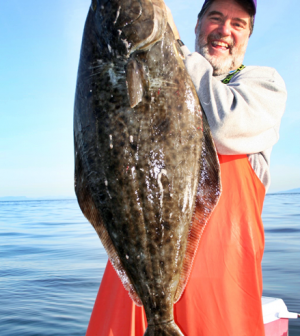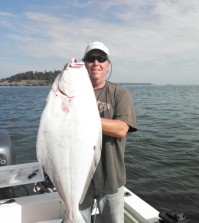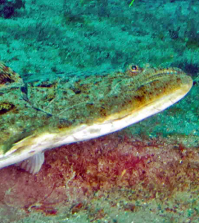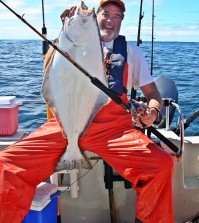Tease Up a Halibut

Halibut fishermen in Washington, Oregon and northern California are at the southern end of the Pacific halibut’s range, and experts in the field estimate that folks down here are fishing on only about two percent of the total halibut population. In other words, halibut are relatively few and far between down here where most of us fish, so whenever we hit the water in search of big ‘buts, we need to do whatever we can to maximize our chances of coaxing one to climb on and come home to dinner. One way to increase your odds is to fish two baits or lures at a time, and adding what some call a “teaser” is one of the quickest and simplest ways to accomplish that.
I’ve mentioned teaser rigs in previous halibut articles on this website, but it’s a topic worth further discussion, because it will, over the long haul, put more brown-and-white flatties in your fish box. In some fisheries for other saltwater species, a teaser may be a hookless lure or attractor of some kind that’s dragged through the water along with a bait or lure, simply for drawing fish in for a closer look at your rig. The actual teaser might be any number of things, from a large spinner blade or series of blades to various baitfish imitations, plastic or vinyl strips, anything that adds some wiggle and flash that might draw the attention of the game fish you’re targeting. When used for billfish and other big-game species, the teaser is usually “fished” on a line that’s separate from the one attached to your rod and reel.
But fishing a separate teaser line for deep-water fish like the Pacific halibut isn’t at all practical, so the best way to incorporate a teaser rig in these parts is to make it a part of the terminal gear, tying it into the leader or main line somewhere above the pipe jig, leadhead or bait rig you’re fishing at the end of the line.
Before we get into describing a few teaser options and how to rig them, let’s talk a little bit about how and why they work to your advantage.
As mentioned earlier, the main purpose of a teaser is to add attraction to your rig, and drawing the attention of more halibut is likely to draw more halibut strikes. Not only does an in-line teaser create movement and color in close proximity to your bait or lure, but the fact that it’s tied a couple of feet up the line, above all those little humps and dips along the ocean bottom, greatly increases the range of its visibility; bottom-hugging halibut that may not notice your main rig dragging along the bottom just might spot that teaser dancing by a few feet further up the water column and swing in for a closer look. The drawing power of this increased visibility is, in my opinion, the greatest benefit of a teaser rig.

The author’s standard teaser, rigged here above a spreader bar.
But teasers serve other purposes and provide other advantages to halibut fishermen. I’m a strong advocate of using bait in conjunction with jigs and other artificials for halibut, and incorporating a teaser into your terminal rig gives you several options to fish baits and lures together. It can be as easy as fishing a whole herring on a spreader rig at the bottom end of your line and using a curl-tail grub, vinyl skirt or strip of pork rind as a teaser above the spreader. Or you can do it the other way around, with a leadhead or pipe jig on the bottom and a strip of salmon belly, halibut skin or a small bait fish on the teaser hook. If you want to use an artificial at both ends of the rig, smear Smelly Jelly or some other gel-type scent on both and you have an “almost” bait-lure combination.
Perhaps the most obvious, but not necessarily the most important, advantage to using a teaser rig is that it gives you two baits/lures in the water at the same time. It won’t double your odds of catching fish or lead to a lot of two-fish hook-ups (which you don’t want when you’re halibut fishing, anyway), but doubling the number of offerings you’re dragging around down there will, over the long haul, put more fish in the boat than you would have caught with a single bait or lure.
A teaser rig can take many forms, depending on an angler’s personal preferences and how much thought and effort he or she wants to put into it. I like to keep things as simple as possible, so I use what I consider a pretty basic set-up. Like most halibut fishermen, I use braided line, and to the business end of that braid I tie a ball-bearing swivel. Next comes two to three feet of 60-pound monofilament (I like Berkley Big Game Clear) with a stout McMahon Snap at the end. I attach my spreader bar, pipe jig or whatever I’m using for my primary lure to the snap. My teaser consists of a size 8/0 to 10/0 octopus hook (Owner SSW Cutting Point), tied on a three or four-inch monofilament leader (again, 60-pound Big Game). I tie the teaser leader into one of the eyes on that swivel that connects the braided line to the mono shock leader. It’s very important that you keep the teaser leader short, so that it sticks out from the swivel and can’t twist around the main line or shock leader. Once the teaser is tied in, it’s simply a matter of threading the hook into a grub body, plastic squid, strip of salmon belly or whatever you choose for a teaser lure. A white, curl-tail grub of three to six inches is often my first choice, and my second is a piece of salmon belly or white halibut skin, also four to six inches long.
If you want to go an even simpler route to building a teaser rig, go out and buy a couple of those Shrimp Fly rigs made by Danielson, South Bend and others, cut them in half so that you have two separate flies and two short leaders, tie one into your line where it connects to your shock leader, and you have a simple teaser rig. The only shortcoming of the Shrimp Flies is that they’re tied on relatively small hooks, size 4/0 or 5/0, which aren’t quite halibut-size.
You may now be asking, “Why not use the entire, two-hook Shrimp Fly rig as a teaser?” Because you’re allowed no more than two hooks when sportfishing in saltwater in both Washington and Oregon, and since that main bait or lure you’re fishing below the teaser has at least one hook, you’re breaking the law if you use both Shrimp Flies with it. By the same token, if you’re fishing bait on a spreader bar in conjunction with a teaser, you have to fish that bait on a single hook rather than the tandem-hook rig you might normally use. Again, no more than two hooks in the entire set-up.










